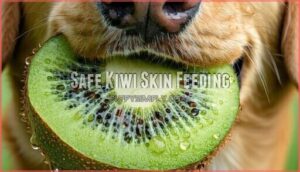This site is supported by our readers. We may earn a commission, at no cost to you, if you purchase through links.

While the fuzzy outer layer isn’t toxic, it packs serious fiber that can overwhelm sensitive stomachs.
Think of kiwi skin as nature’s scrub brush – loaded with vitamin C and antioxidants, but tough on digestion.
You’ll want to wash it thoroughly, remove any pesticide residue, and start with tiny portions.
Some pups handle it like champs, while others might experience upset stomachs or allergic reactions.
The key lies in knowing your dog’s tolerance level and watching for warning signs.
Smart preparation and portion control make all the difference in whether this nutritious treat becomes a hit or miss.
Table Of Contents
Key Takeaways
- You can give your dog kiwi skin, but it’s risky – While not toxic, the tough, fibrous texture can cause digestive upset, choking hazards, and stomach problems, especially in sensitive dogs.
- Start with tiny portions and watch closely – If you decide to try kiwi skin, give your dog just a fingernail-sized piece first and monitor for 24 hours for signs of allergic reactions, vomiting, or unusual behavior.
- Proper preparation is essential – You’ll need to wash the kiwi thoroughly to remove pesticides, cut it into small bite-sized pieces, and consider your dog’s size when determining portion control.
- Peeled kiwi is the safer choice – You’ll get the same nutritional benefits (vitamin C, fiber, antioxidants) by removing the skin entirely, which eliminates most risks while still providing a healthy treat for your pup.
Kiwi Skin Safety
While kiwi skin isn’t toxic to your dog, it can cause digestive problems because of its tough texture and high fiber content.
Although kiwi skin won’t poison your pup, its fuzzy texture can wreak havoc on sensitive stomachs.
You’ll want to understand the specific risks and benefits before deciding whether to include this fuzzy exterior in your pet’s snacking routine.
Nutritional Value
Kiwi skin packs a nutritional punch with impressive Vitamin Composition, including vitamin C and E.
The Mineral Content offers antioxidants and polyphenols that benefit humans substantially. As a Fiber Source, it aids digestion, while Hydration Benefits come from high water content.
However, these kiwi skin benefits don’t translate to dog nutrition. The low Caloric Intake makes it healthy for people, but dogs don’t require this kiwi nutrition supplement.
While kiwi skin offers benefits, remember that it can pose choking hazard risks for dogs.
Digestive Issues
While kiwi skin offers nutritional benefits, your dog’s digestive system might struggle with its tough, fibrous texture.
Fiber overload can trigger gut sensitivity, leading to uncomfortable bloating concerns and noticeable stool changes.
The skin’s insoluble fiber may interfere with nutrient absorption, causing digestive issues that upset your pup’s gastrointestinal health.
Kiwi skin digestion isn’t always smooth sailing for sensitive stomachs.
Can Dogs Eat Kiwi Skin
Dogs can technically eat kiwi skin, but it’s not the wisest choice for your furry friend.
While kiwi skin safe isn’t entirely accurate, is kiwi skin toxic? No, but it presents several concerns.
The fuzzy texture and tough consistency make it difficult for dogs to digest properly.
Many pups simply don’t enjoy the skin taste, finding it too tart or rough compared to the sweet flesh inside.
Pesticide concerns make washing essential if you’re considering this option.
Wild kiwis and organic options reduce chemical exposure, but the texture preference issue remains.
Most dogs eat kiwi much better when you remove the skin entirely.
The tough exterior can cause digestive upset or become a choking hazard, especially for smaller breeds.
Regarding kiwi skin for dogs, peeling first creates a safer, more enjoyable experience for your pet.
This approach helps avoid potential issues, making kiwi a more enjoyable and safer treat for dogs.
Kiwi Skin Benefits
While kiwi skin contains beneficial nutrients like fiber, vitamin C, and antioxidants that can support your dog’s digestive health and immune system.
These benefits come with important considerations, as you’ll need to weigh these potential advantages against the risks of digestive upset and choking hazards.
Before deciding whether kiwi skin is right for your pet, you must carefully evaluate these factors to make an informed decision.
Fiber Content
Nutritional powerhouses often hide their best features in plain sight.
Kiwi skin for dogs packs impressive insoluble fiber that works wonders for your pup’s digestive system.
This fiber acts as nature’s broom, promoting healthy stool consistency and supporting overall gut health.
Key Fiber Benefits for Dogs:
- Promotes regular bowel movements and healthy digestion aid
- Improves stool consistency through natural bulking action
- Supports beneficial gut bacteria growth
- Helps maintain ideal digestive tract function
- Provides gentle cleansing action for your dog’s intestinal system
Vitamin C
Beyond fiber benefits, kiwi skin packs impressive vitamin C levels that can boost your dog’s immune support naturally.
This powerful nutrient helps fight off infections and promotes healthy skin.
However, dogs typically produce their own vitamin C, so deficiency symptoms are rare.
While kiwi skin offers dietary sources of this vitamin, supplementation risks from overfeeding remain a concern for proper dog nutrition.
Antioxidants
When your dog munches on kiwi skin, they’re getting a powerful dose of antioxidants that act like tiny bodyguards against free radicals.
These cellular protection warriors help combat oxidative stress, supporting your pup’s immune system naturally.
The antioxidant benefits in kiwi skin can boost dog health by reducing inflammation and promoting overall wellness through improved dog nutrition.
Feeding Kiwi Skin Risks
While kiwi skin offers nutritional benefits, you’ll need to bear in mind several important risks before sharing it with your dog.
The tough, fibrous texture can create choking hazards and digestive blockages, and some dogs may experience allergic reactions or stomach upset from the high fiber content.
Choking Hazard
Kiwi skin’s tough, fibrous texture poses a real choking hazard for dogs.
Size matters here – small breeds face greater risks than larger ones due to breed differences in swallowing reflex. The skin can easily block your dog’s airway, creating a dangerous situation.
Always supervise feeding and know emergency action steps. Remove kiwi skin risks by peeling fruit before serving to prevent dog choking incidents.
Allergic Reactions
Some dogs develop allergic reactions to kiwi skin, just like humans.
Just like their human companions, some pups can develop unexpected allergic reactions to kiwi skin.
Watch for allergy symptoms including skin redness, hives, or vomiting after feeding.
Reaction severity varies by breed predisposition and individual sensitivity.
If you notice these dog health risks, take immediate actions by removing kiwi skin from their diet and seeking veterinary care to address potential allergic reactions.
Digestive Upset
High fiber content in kiwi skin can trigger digestive issues in sensitive pups.
When dogs eat kiwi skin, fiber overload disrupts gut bacteria balance, leading to upset stomach and stool changes.
Sugar sensitivity may cause additional discomfort, while vomiting risks increase with overconsumption.
Your dog’s digestion wasn’t designed for tough fruit peels, making moderation absolutely essential, as fiber overload and digestive issues can be severe.
Preparing Kiwi Skin
When you’re preparing kiwi skin for your dog, proper washing, peeling, and dicing make all the difference between a safe treat and a potential health risk.
You’ll need to thoroughly scrub the fruit to remove pesticides and dirt, then carefully remove the tough skin before cutting the flesh into small, bite-sized pieces that won’t pose a choking hazard.
Washing
Before your pup can safely enjoy this fuzzy treat, proper preparation starts with thorough cleaning.
Rinse the kiwi under cool running water while gently scrubbing the surface with your hands or a soft brush. This washing method guarantees effective dirt removal and pesticide removal from the skin.
A specialized cleaning tool can aid in this process.
Safe washing protects dog health when you’re considering whether dogs eat kiwi skin as fruit for dogs, maintaining essential dog safety standards and ensuring complete concepts of safety are followed.
Peeling
A sharp vegetable peeler becomes your best friend when preparing kiwi for your furry companion.
Peeling benefits include eliminating choking hazards and reducing digestive concerns that plague many pet owners. Consider using a specialized peeling tool for efficiency.
Here are three essential peeling techniques for dog safety:
- Gentle strokes – Remove kiwi skin with light pressure
- Complete removal – Make certain no fuzzy bits remain
- Smooth finish – Check for rough patches before serving
Dicing
Size matters when creating bite-sized kiwi pieces for your furry friend.
Cut the peeled fruit into small, uniform cubes that match your dog’s mouth size.
Dicing benefits include preventing choking hazards and promoting easy digestion.
Smaller dogs need tiny portions, while larger breeds can handle slightly bigger pieces.
Safe portions guarantee your pup enjoys this healthy treat without worry.
Kiwi skin offers antioxidant and fiber benefits, but it’s best to remove it before serving to ensure a healthy treat.
Kiwi Skin Serving Size
When you’re ready to offer your dog kiwi skin, start with just a tiny piece about the size of your fingernail to test their tolerance.
You’ll want to watch your pup closely for the next 24 hours to spot any signs of stomach upset, loose stools, or unusual behavior before deciding if kiwi skin works for them.
Moderate Feeding
Why should portion control matter when offering kiwi to your dog?
Treat frequency plays a vital role in maintaining dietary balance and healthy caloric intake.
Start with gradual introduction—one small piece initially.
Dog treats shouldn’t exceed 10% of your dog’s daily calories.
Consider the benefits of a kiwi skin product for your pet.
Remember, moderation prevents digestive upset while ensuring your pup enjoys this nutritious snack safely within their regular dog diet, emphasizing the importance of dietary balance and healthy caloric intake for a happy pet.
Monitoring Reactions
After you let dogs eat kiwi skin, watch closely for warning signs.
Your pet’s digestive system might react unexpectedly, so monitor these key areas:
- Allergy Symptoms – itching, swelling, or breathing issues
- Digestive Changes – vomiting or unusual stool consistency
- Behavioral Changes – lethargy or restlessness
- Appetite Shifts – refusing food or excessive hunger
Kiwi skins have valuable antioxidant properties, but moderation is still key.
Contact your veterinarian immediately if concerning symptoms appear.
Kiwi Skin Alternatives
If you’re concerned about feeding your dog kiwi skin, you can offer them peeled kiwi fruit instead, which provides the same nutritional benefits without the digestive risks.
Other dog-safe fruits like apples (without seeds), bananas, and blueberries make excellent alternatives that won’t cause the stomach upset that kiwi skin might trigger, providing a good source of nutritional benefits.
Kiwi Fruit
Instead of kiwi skin, you can safely offer your dog the peeled kiwi fruit itself.
This sweet, tangy treat provides excellent nutrition without the tough exterior that might cause digestive issues.
When dogs eat kiwi flesh, they get vitamin C and fiber benefits.
Choose ripe kiwi varieties, store them properly, and dice into small pieces for safe fruits for dogs enjoyment.
Other Fruits
Many safe fruits for dogs offer excellent alternatives when kiwi skin concerns you.
Consider these dog-friendly options that provide similar nutritional benefits without the digestive risks:
- Blueberries – packed with antioxidants and easy to digest
- Apple slices (seedless) – high fiber and vitamin C
- Banana pieces – potassium-rich and gentle on stomachs
- Watermelon chunks – hydrating and low-calorie
- Strawberries – vitamin C boost with natural sweetness
If you’re looking for more variety, remember that honeydew offers hydration and essential nutrients.
Common Kiwi Skin Mistakes
Many dog owners make two critical errors when feeding kiwi skin: giving too much at once and failing to watch their pet’s reaction afterward.
You’ll want to start with tiny amounts and monitor your dog closely for any signs of digestive upset, choking, or allergic reactions before offering more, to avoid digestive upset.
Overfeeding
When dogs eat kiwi skin regularly without portion control, you’re setting up weight problems.
This fuzzy fruit packs more calories than you’d think, and overfeeding disrupts dietary balance faster than a dropped treat disappears.
Stick to the 10% treat limits rule for your dog’s total calorie intake.
Smart dog feeding precautions and dog treat moderation prevent obesity-related health issues down the road.
Not Monitoring Reactions
Ignoring your dog’s response after introducing kiwi creates unnecessary risks.
Watch for allergy symptoms like itching or swelling, plus digestive changes including altered stool consistency. Behavioral changes often signal discomfort before physical symptoms appear.
When dogs eat kiwi for the first time, adverse reactions can develop quickly. Schedule a vet checkup if you notice concerning signs, prioritizing pet safety and dog health over convenience.
Kiwi Skin Health Concerns
While kiwi skin isn’t toxic to dogs, it can contribute to several health problems if you’re not careful about portion sizes and your dog’s individual sensitivities.
You’ll want to watch for signs of obesity from excess sugar intake, potential blood sugar spikes in diabetic dogs, and allergic reactions that can develop over time with repeated exposure to certain foods, which may lead to allergic reactions.
Obesity
Over 50% of US dogs struggle with excess weight, making treat moderation essential for your pup’s health.
Kiwi’s natural sugars can contribute to canine obesity when fed regularly, leading to serious conditions like arthritis and heart disease.
Practice calorie control by limiting kiwi portions and considering healthier treat alternatives. Remember, even nutritious snacks require careful dog sugar intake management.
Diabetes
Since kiwi’s high sugar content can trigger dangerous blood glucose spikes, diabetic dogs should avoid this fruit entirely.
The natural sugars disrupt insulin response, making blood sugar management nearly impossible.
Instead of risking your pup’s health, choose safe treats specifically formulated for diabetic dogs.
Always consult your vet before introducing any new foods to guarantee proper dog dietary advice for diabetes.
Allergies
Some dogs develop kiwi allergies, though it’s relatively uncommon.
Watch for these kiwi allergy symptoms after feeding:
- Itching, scratching, or skin irritation around the face and paws
- Digestive upset including vomiting, diarrhea, or excessive drooling
- Respiratory issues like coughing, wheezing, or difficulty breathing
Cross-reactivity risks exist with other fruits, which necessitates proper allergy testing. Always practice gradual introduction and seek veterinary consultation.
Safe Kiwi Skin Feeding
When you’re ready to offer your dog kiwi skin safely, you’ll need to follow specific veterinary guidelines and monitor your pet’s response carefully.
Start by consulting your veterinarian first, then wash the kiwi thoroughly, cut it into small pieces, and watch for any digestive upset or allergic reactions during the first few feedings, to ensure a safe introduction and minimize the risk of allergic reactions.
Consult Veterinarian
Before making dietary changes involving kiwi for pets, schedule a dog dietary consultation with your veterinarian.
They’ll assess your canine’s health conditions, breed sensitivity, and potential allergic reactions. A professional evaluation guarantees proper portion control and identifies any concerns specific to your dog’s needs.
Your vet knows your pet’s medical history best and can provide personalized guidance for safely introducing kiwi, ensuring a professional evaluation that addresses all aspects of your dog’s health.
Follow Guidelines
Pet-parent responsibility means sticking to proven dog dietary guidelines when introducing kiwi skin.
Start with gradual introduction—one tiny piece initially. Practice portion control by limiting treats to 10% of daily calories.
Always prioritize vet consultation before adding new foods. Choose established safe treats over experimental options.
Following these dog safe protocols guarantees your furry friend enjoys kiwi without compromising their health or violating dog dietary restrictions, ensuring complete concepts of dog safe protocols are met.
Monitor Dog’s Health
Following vet guidelines means watching your dog closely after introducing kiwi skin.
Keep an eye on these key health indicators:
- Allergy Symptoms – Watch for itching, swelling, or unusual behavior
- Stool Consistency – Monitor for diarrhea or digestive upset
- Eating Habits – Notice changes in appetite or food preferences
- Energy Levels – Track lethargy or hyperactivity changes
Schedule regular vet checkups to guarantee your dog’s digestive system stays healthy.
Frequently Asked Questions (FAQs)
Can dogs eat Kiwi?
Yes, dogs can eat kiwi in moderation.
Remove the skin and seeds, then cut into small pieces to prevent choking.
This vitamin C-rich fruit makes a healthy occasional treat for your furry friend.
Is Kiwi skin toxic to dogs?
Like knights of old avoiding poisoned apples, you shouldn’t worry about kiwi skin being toxic to your dog.
It’s safe but tough to digest, potentially causing stomach upset or choking, so it’s best peeled off.
How much Kiwi can a dog eat a day?
Your dog can safely enjoy small pieces of kiwi as an occasional treat.
But limit it to just a few small slices per day to avoid digestive upset from the high fiber content.
Are Kiwis good for dogs?
Hit the nail on the head—kiwis are nutritious treats for dogs.
They’re packed with vitamin C, fiber, and potassium.
You can safely share small pieces occasionally, but always remove the skin first.
Can a dog lick a Kiwi?
Your dog can safely lick a kiwi, but it’s not recommended.
The fruit’s high sugar content and potential for digestive upset make it better to offer small, peeled pieces as an occasional treat instead.
Can Kiwi be used as a training treat for dogs?
Kiwi can work as training treats, but it’s not ideal.
The fruit’s soft texture makes it messy and impractical for quick rewards.
You’ll want smaller, firmer treats that won’t distract from training sessions.
What happens if my dog eats kiwi skin?
If your pup munches on kiwi skin, don’t panic.
The fuzzy exterior isn’t toxic but contains high fiber that might upset their stomach or cause diarrhea.
Monitor them closely and contact your vet if symptoms persist.
How much kiwi can a dog eat?
Ironically, while you’re carefully counting calories for yourself, your dog needs just a small slice or two of kiwi as an occasional treat.
Not exceeding 10% of their daily food intake to avoid digestive upset.
Does kiwi upset a dog’s stomach?
Yes, kiwi can upset your dog’s stomach if they eat too much. The high fiber content may cause diarrhea or digestive issues. Start with small pieces and watch for reactions.
Can dogs have mango or kiwi?
Don’t worry about exotic fruits being off-limits for your furry friend.
Dogs can safely enjoy both mango and kiwi in small portions.
Just remove pits, peel the skin, and cut into bite-sized pieces to prevent choking.
Conclusion
Remember when Fido would’ve been happy with table scraps from the Victorian era.
Today’s pet parents face more complex nutrition questions. Can dogs eat kiwi skin? Yes, but proceed cautiously.
You’ve learned that proper preparation, tiny portions, and careful monitoring are essential. While kiwi skin offers valuable nutrients, it’s not mandatory for your dog’s health.
Start small, watch for reactions, and consult your veterinarian if you’re uncertain. Your dog’s individual tolerance determines whether this fuzzy treat works.

















